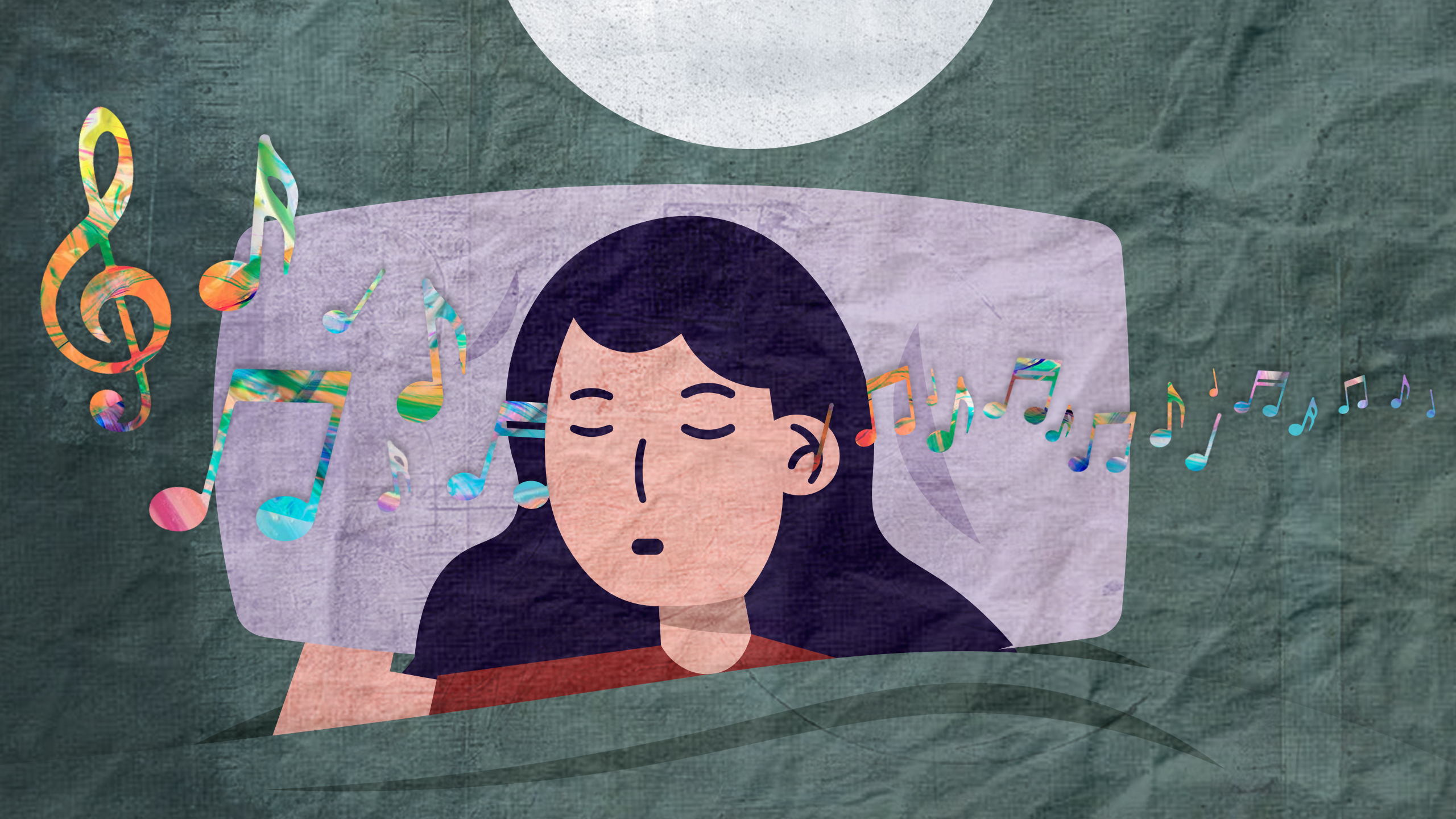
How ‘Color Noise’ Can Dramatically Improve Your Sleep, Boost Productivity & Lower Anxiety
Have you ever spent hours tossing and turning in bed, trying to shake thoughts about work or other stresses from your mind with no luck?
If so, take comfort in knowing you’re not alone. Every individual has an endless supply of worries to fend off as they try to settle down for bed. Work worries, family stresses, and relationship troubles are just a few of these stresses that might impact your ability to fall asleep or keep your anxiety at bay. Millions of people struggle to fall asleep every night, and all have varying ways of getting themselves to settle down for the night and get some shut-eye.
These winding-down methods range from meditating or reading a book all the way to bringing a warm glass of milk to bed. While these methods may prove to be effective for some, many others find it difficult to quiet their minds through meditation and are left feeling anxious, sleep-deprived, and frustrated as they toss and turn throughout the night.
Unfortunately, many people don’t even know what color noise is, let alone the wonders it can do for your ability to fall asleep at night. Color noise can also reduce your anxiety and help you focus and be more productive at work. In this article, we’re talking all about the power of color noise and how it can not only improve your sleep quality but boost your productivity and lower anxiety as well.
What Is Color Noise?
In the field of audio engineering, different types of noise are assigned different colors based on their frequency spectrum. This is because people’s responses to noise vary depending on its frequency. Depending on the nature of the noise, it may be used for calming or therapeutic purposes.
The term “noise” has come to be used in a broad sense to describe any distracting or annoying sound from city traffic to bad music. However, white noise, pink noise, and brown noise are all examples of colored noise because they are all random sound signals with a fixed spectral frequency. The density of noise of each of these colors varies.
Sound and light are both forms of energy transmitted as waves that can be detected by the human brain. Light perception is what allows us to tell red and green apart, and colored noise follows the same logic. Green noise, just like a green light, is defined by the frequency of its accompanying sound waves.

Learn The Secrets Of Some Of The Greatest Minds In The World
The Greatness Mindset shows you how to unleash your greatness by clarifying who you are, discovering your Meaningful Mission, and stepping into how you can make an authentic, unique contribution to the world.
Learn MoreDifferent Colors of Noise
However, learning to distinguish the many forms of noise is not as simple as learning to tell red from green. Noise colors are theoretically determined by their frequencies, so they are abstract concepts. These frequencies have no discernible pattern, yet they do follow well-defined spectral density formulas, and there is a specific formula for each color of noise.
White Noise
White noise is usually the color noise most people have heard of. Remember that static sound that happens when you lose signal on an old television? That’s white noise. As far as noise colors go, white noise is the most well-known and typical. It’s characterized as a continuous signal with varying frequencies and constant volume. White noise, like the color white, is the sum of all colors and all frequencies. This means that white noise does not favor any one frequency range.
White noise may seem unpleasant or shrill to those with sensitive ears. This is not because the high frequencies in white noise signals are more abundant than the mid and low frequencies; rather, it is because our ears are tuned to hear them more clearly. Some individuals’ ears are just more sensitive to these frequencies than others.
Pink Noise
Pink noise is a signal in which the energy of each octave is uniformly distributed over all frequencies. The primary difference between pink noise and white noise is that the former is organized in a way that’s more sympathetic to the human ear. If that sounds complicated, don’t worry. Let’s unpack the details!
The human ear is more adept at picking up higher frequencies than it is at picking up lower ones. Consequently, a pink noise signal loses -3dB (decibels) in power for every octave up. For instance, if the spectrum’s lowest octave is being played at 70dB, the next-lowest note should be at 67dB, and so on.
The reason for this is that pink noise is meant to mimic the way white noise would sound to our untrained ears. It’s an attempt to generate a noise signal that sounds uniform, despite the fact it doesn’t perfectly mimic white noise analytically. Interestingly, pink noise occurs naturally all the time. Some examples of pink noise include rustling leaves, steady rain, wind, and heartbeats.
Brown Noise
Brown noise is the deepest and most bass-heavy of the color noises since it has even less high frequencies than pink noise. Imagine the roar of a distant thundercloud or the spray from a waterfall — these are great examples of naturally occurring brown noises.
Brown noise is the only colored noise not called for a hue but rather a researcher. In 1827, Robert Brown first observed how particles in fluid seem to move around randomly when suspended.
Albert Einstein provided a mathematical formula to describe this phenomenon — which scientists had named Brownian motion — a century later. Applied to electronic music, the formula produces a low, rumbling roar. This is what we call brown noise.
Brown noise is comparable to pink noise from an audio engineer’s perspective, but it features an even steeper increase in energy levels from low to high frequencies (in this case, a -6dB reduction per octave). Brown noise has a deeper tone than white and pink noise, making it ideal for quiet, focused work like reading or relaxing.
Violet Noise
To put it plainly, violet noise is the polar opposite of brown noise. Whereas brown noise tends to have a dull, muted tone, violet noise tends to be shrill and piercing. Based on a similar random pattern, it boosts the signal by 6dB for each octave from low to high.
Violet noise is particularly interesting because, while it may seem unpleasant to many, it can actually be used as a form of therapeutic treatment for tinnitus.
Gray Noise
Gray noise can be explained with the understanding of A-weighting. This concept describes a modification of sound levels that takes into account how people’s ears process sound.
A-weighted gray noise mimics the human hearing range but provides the opposite frequencies to the brain. Therefore, gray noise sounds as though all frequencies in the spectrum are being played at the same volume (even though this is not the case).
Although there is no discernible difference in energy between the low and high frequencies of gray noise, it may have a more homogeneous and “blocky” sound than the other noise hues. You can think of gray noise as a specially-tailored for the human ear form of white noise.
Green Noise
Green noise is a form of environmental sound that mimics the background hum we hear in the wild by emphasizing frequencies in the middle of the audible range. Rather than being a random noise signal, it sounds like a field recording. Because it sounds like a bustling street, green noise is perfect for the background of a movie scene.
What Is Black Noise?
Black noise is merely the absence of sound — total silence. Though this may be the best option for getting restful, undisturbed sleep, there are so many sounds going on in everyone’s household that total silence is nearly impossible to achieve.
Join In 200 Million+ On The Journey to Greatness
The Facts About and Benefits of Colored Noise
White, pink, and Brown noises’ primary benefits, whether generated by an old-fashioned fan or cutting-edge sleep software, are not about the noise itself but rather the noise’s capacity to mask other sounds. Generally speaking, the ideal noise for you will be the one that sounds most pleasing to your ears. This means that there’s no answer to “Which is the best colored noise for sleep or focusing?” You simply must test them out yourself and see which one you like.
However, despite decades of study, there is still no conclusive evidence linking any specific noise to improved sleep, focus, or disposition. Studies have demonstrated that all three types of noise (white, pink, and brown) promote concentration and productivity. White noise has been shown to help adults fall asleep 38% faster.
It’s worth mentioning that these findings were questioned in a recent review of the literature since many of the studies were either too short or relied too heavily on self-reported data and too few participants. The review’s authors went so far as to claim that noise pollution alone can prevent people from getting enough rest. Some authors even claimed that prolonged noise pollution while you sleep can have adverse effects on one’s hearing.
However, every individual is unique. Therefore, people require different things to feel relaxed and productive. The researchers did go on to clarify that as long as the noise isn’t being played too loud (above 70 decibels), your ears will not be damaged.
Therapeutic Properties of Colored Noise
Colored noise isn’t only for sleeping, however, as there are a wide variety of applications for colored noises. For example, pink noise is useful for fine-tuning sound systems before a performance, and it can also be utilized for mixing and mastering, and data for random number generators in computer programming can be generated using white noise. So why do so many individuals use these colored noises therapeutically?
Well, it’s all about how our brains are wired. When we hear something in silence, our basic instincts kick in. Think about it — our hearing is an important tool our ancestors used to keep themselves safe and detect danger nearby. When there is no one else nearby, even the sound of a man strolling can cause us to feel threatened. The same is not true when there is sufficient context to keep our minds occupied.
Since many people have trouble falling asleep in complete silence due to the extraneous sounds occurring in their houses or in the street, white noise machines are a popular way to alleviate this problem. If you had an entirely blank canvas, even the smallest of white dots would be noticeable. The same thing happens when there’s no background noise to compete with other sounds; we tend to lose concentration quickly.
Noise fills in for the silence by delivering a plethora of auditory data to keep our minds occupied. For this reason, many students find that background noise helps them focus on their studies by masking out any other sounds.
Bless Your Ears By Finding the Perfect Color Noise for You
Not all sounds are created equal. When sound waves interact with our brains, they produce a spectrum of tones, much like visual light waves do. The classification of noise colors, however, is less natural and more mathematical. Still, they reveal a great deal about our social behavior. What we hear, what we don’t hear, and how we hear can all be better understood with the help of noise colors.
Learning about the various kinds of noise will help you comprehend the nature of sound outside of the pitch range. They’re as unadulterated and unemotional as it gets when it comes to sound, so it’s up to you to experiment and find the perfect noise color for you!
Greatness Authors
Greatness Authors is a collection of writers, thinkers, curiosity experts, and students of the world who are committed to bringing you the most up-to-date, impactful, and inspiring information surrounding Greatness topics.

Do You Have to Be a Morning Person to Be Successful? Here’s What Both Sides Have to Say

9 Reasons You’re Tired All the Time & How to 10x Your Energy

How to Have a Healthy Romantic Relationship Even if You Share Different Beliefs

The 7 Best Vitamins to Naturally Promote Better, Uninterrupted Sleep According to Shawn Stevenson

The Science of Forming Healthy Habits & Letting Go of Bad Ones, According to Author James Clear










